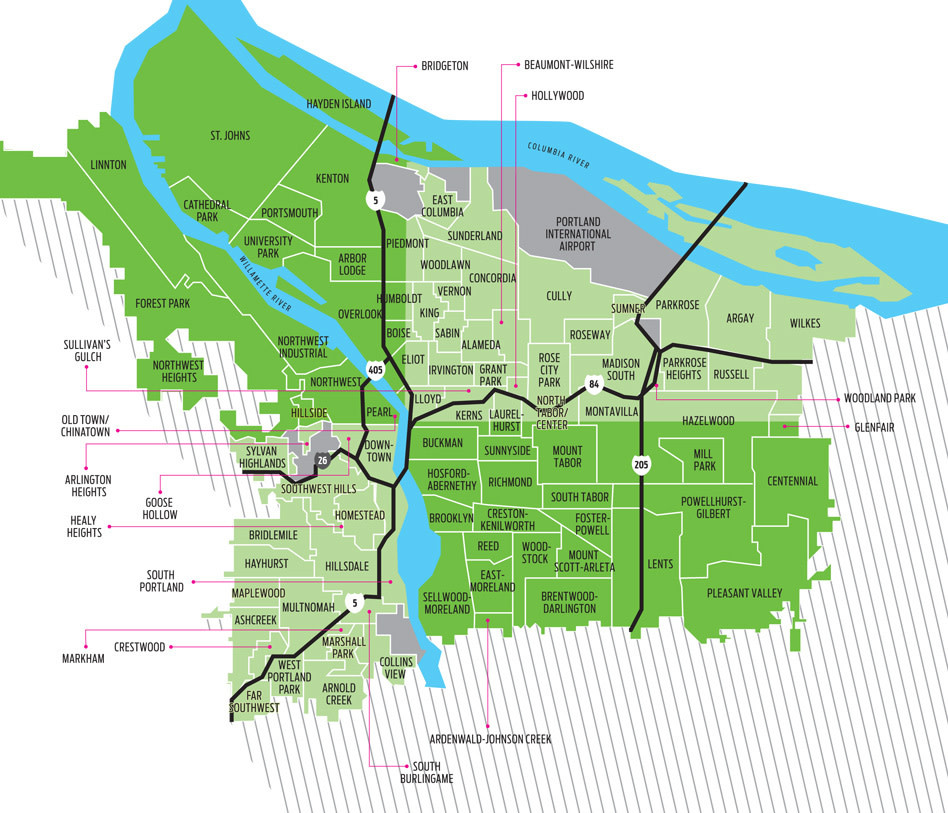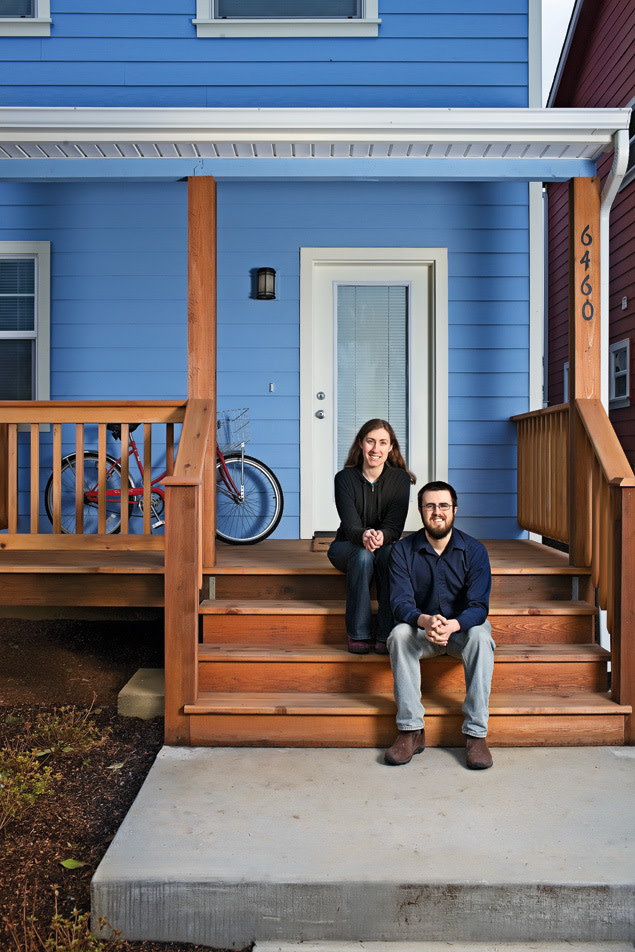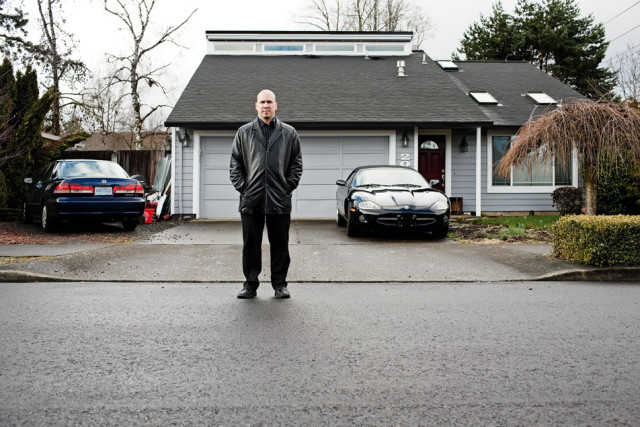Buy, Sell, Rent, Keep?

KEY QUESTIONS
Rent or buy?
Some financial experts equate renting with flushing money down the toilet. But in some cities, including Portland, renting may make more sense than buying— even with today’s low loan rates and sales prices that have dropped by nearly 10 percent in the past year.
A couple of reasons: (1) In Portland, equity in single-family homes is expected to fall by $88,000 between now and 2012, according to a recent study by the National Low Income Housing Coalition. (2) By renting, Portlanders can save about $700 per month in maintenance, insurance, and utility costs, which local homeowners typically have to pay. “We need to step away from looking at buying a home as a profit-making investment,” says Danilo Pelletiere, the Housing Coalition’s research director and coauthor of the study. Pelletiere offers these suggestions if you’re thinking of buying:
Track the Trends
It’s important to assess factors like unemployment and foreclosure rates, both of which are on the rise in Oregon. Such trends negatively affect home values and the ability of homeowners to build equity. One foreclosed home can reduce the value of neighboring homes by as much as 10 percent.
The Rule of Fifteen
A home’s purchase price should be no more than fifteen times the yearly rental rate of similar-size houses in the area. Because annual rental rates and home prices should fall within about 7 percent of each other, this simple test reveals whether a home’s price is inflated.
Get Personal
If, after five years (the standard amount of time it takes to build equity), the home is worth less than what you paid, will you still be happy with it? If the answer is yes, then chuck those other principles. Ultimately, Pelletiere says, the owner decides a home’s true value.—Lynette Sanchez
Who can use the new federal $8,000 tax credit?
The Obama administration’s American Recovery and Reinvestment Act is designed to make it easier for first-time home buyers to get into the market by allowing an $8,000 tax credit. The offer is generous—the credit doesn’t have to be repaid, and the definition of “first-time home buyer” extends to anyone who hasn’t owned a home in the past three years. But there’s a time limit: you have until November 30 to take advantage of the offer, which is administered through the IRS via Form 5405. A simple explanation of the tax credit is available from the National Association of Homebuilders: federalhousingtaxcredit.com.
IF YOU’RE STARTING OUT…
Buy Smart

Image: Daniel Root
Buyers: Patrick Stenger and Becky Lennon
Occupations: Becky, nanny; Patrick, restaurant manager
Location: Cully, Northeast Portland
The property: 1,370 square feet, three bedrooms, two baths
Date purchased: 2008 price $219,000
The neighborhood About twenty minutes north of downtown, Cully lies just south of Portland International Airport. The area has a mixture of aging 1950s and 1960s ranch and cottage styles near NE Killingsworth Street. The Lennons’ home is located in the Helensview development. Built in 2008, Helensview is a LEED-certified neighborhood built by HOST Development Inc, a local nonprofit home developer.
Market watch Cully’s median home price climbed by nearly 1 percent last year, and most homes took about two months to sell.
Buyer’s tip “We thought we’d have to put 20 percent down,” Becky Lennon says of the couple’s first-time-buying jitters. “But realizing we didn’t have to was huge.” With help from family, the couple put down 15 percent. And because together they earn less than $54,000—the state’s average median income for a family of two—they received an additional $5,000 in assistance from HOST Development, which helped lower their interest rate from 6.75 to 6 percent. The home’s ten-year warranty and energy-saving features also eased their decision to buy.
Expert eye Buyers can still put as little as 3.5 percent down on a mortgage, HOST Development broker Alyssa Isenstein Krueger says. “If you have a good credit score—think seven hundred—and steady income, there are ways around it.” She also points out that not all lenders are equal. Go to hostdevelopment.com or the Portland Housing Center at portlandhousingcenter.org to find those who specialize in serving first-time home buyers.
Expert eye Krueger says many people are confused about the $8,000 federal tax credit offered in February’s housing stimulus package to first-time home buyers. While the credit can be claimed retroactively on 2008 taxes, it can’t be used for a down payment, she says, noting that buyers can claim it only after they’ve closed on a purchase. If you’ve already filed your 2008 taxes, you would fill out Form 5405 to claim the credit and Form 1040 to amend your 2008 return.—Brian Barker
Expert Tip: All lenders are not equal. For a list of those that specialize in serving first-time home buyers, visit hostdevelopment.com or the Portland Housing Center at portlandhousingcenter.org
IF YOU’RE ON SOLID GROUND
Protect Your Investment

Image: Daniel Root
Owners: Chris and Nancy Crean
Occupations: Chris, attorney; Nancy, special-projects coordinator
Location: Irvington, Northeast Portland
The property: 1924 Craftsman bungalow with 1,800 square feet, three bedrooms, two baths
Date purchased: 1998 price $220,000
Current assessed value: $550,000
The neighborhood Irvington, which is only twelve minutes from downtown and is served by five bus lines, is full of tidy Craftsman-style homes served by excellent schools like Irvington Elementary. The Creans’ home sits on a corner lot, near Irving Park.
Market watch Last year, 110 homes sold in Irvington, down from 142 in 2007, but the neighborhood’s median price of $546,000 is holding steady.
Keeper’s tip “Ten years ago, $220,000 seemed like a scandalous amount of money for a house,” Chris Crean says. “Now, I think we got in at a good time.” Rising home prices during 2005 and 2006 did tempt the couple to sell. “At one point people were telling us we could get $700,000 for this house. I can’t say we didn’t think about it,” he says. “But our neighbors next door and across the street both have boys the same age as my son—they’re best friends. We didn’t want to rip him out of that close social network.”
Keeper’s tip After refinancing in 2004, the Creans lowered the rate on their primary mortgage to 4.9 percent and began remodeling an upstairs bedroom. “We put in oversize windows, built-in cabinets, and a bathroom,” Chris says. The process took about five months, but the family gained a new master bedroom and a bathroom.
Expert eye With the housing market still settling, it’s a good idea to keep remodeling projects in check, says Gary Majors, president of the Portland Metropolitan Association of Realtors. “If you give a minor face-lift to a bathroom, you might make your money back,” he says of future sale potential. But to owners expecting to recoup 100 percent of their costs for larger jobs, like a $15,000 or $20,000 kitchen remodel, Majors says, “We just don’t see that.”—BB
Expert Tip: Conserving energy is a "guaranteed return on investment," says Mike O’Brien of the City of Portland’s Bureau of Planning and Sustainability. Energy Trust of Oregon provides cash incentives for energy-efficient improvements like solar panels. For a free home audit, go to energytrust.org.
KEY QUESTION
Should I refinance?
Homeowners generally should ask themselves whether they’ll save enough on interest to justify the closing costs, says Steve Emory, a broker with Pacific Residential Mortgage. “The more you owe, the more impact a rate savings has.” Understating a home’s value is also important—if you borrow less than 80 percent of a home’s worth with a conventional loan, you won’t get tagged with mortgage insurance. What about getting approved? Emory says to be prepared with two years’ worth of tax returns and W-2s, thirty days’ worth of pay stubs, and a month’s worth of bank statements. Under the Obama administration’s “Making Homes Affordable” plan, as many as five million homeowners may now be able to refinance and avoid foreclosure. Another three to four million homeowners may be able to modify their loans. For loan modification, you’ll need to be able to demonstrate financial hardship, but you needn’t be behind on payments. If you’re already in foreclosure, you still may be eligible for help. To find out who qualifies, and to learn how to avoid mortgage scams, visit financialstability.gov/makinghomeaffordable, or call the Homeowner’s HOPE Hotline at 888-995-HOPE.
TO SELL SMART
Buck the Trend

Image: Daniel Root
Seller: Dan Huckestein
Occupation: Artist
Location: Overlook, North Portland
The property: 3,205 square feet, three bedrooms, one and a half baths; built in 1941
Date purchased: May 2005 price $379,000
Sold: January 2009, for $580,000 Days on market 37
The neighborhood Overlook is eleven minutes by car from downtown and a short walk from the Overlook Park MAX light-rail stop. Huckestein’s home is steps away from Madrona Park.
Market watch In 2008, median home prices grew to $315,000, up more than half a percentage point from 2007.
Seller’s tip “I really bucked the trend,” Huckestein says of the old home-selling adage dictating that sellers should strip homes of personal flair in order to appeal to a wide variety of potential buyers. “I just said, ‘No, that’s not the way this is supposed to be. I’m an artist; I have lots of expressive things. I’m not neutralizing it. This house is about character, and whoever buys it is going to have an emotional reaction to the house.’”
Expert eye “No home is going to appeal to everyone,” says Maureen Bray of Room Solutions, a Portland-based business that teaches homeowners how to maximize a home’s visual appearance during showings. “You have to target what the neighborhood demographics tell you. If you’re in a family neighborhood where everyone has school-age children and all the homes are ranch-style houses in the $300,000 range, don’t stage the place for the ultratrendy person who wants to live in the Pearl.” Staging services, which even provide furniture rentals, can cost up to $1,500, but sellers can deduct the expense from their taxes.
Expert eye “Buyers continue to be willing to pay top dollar for a home that is in tip-top shape says Sue Coon, the agent who listed Huckestein’s home. “But buyers in today’s market are still very cautious not to overpay. Most offers come the first week [the home is listed], and are 5 to 10 percent below asking price. Savvy sellers understand they may not get another offer.” People who view a home in the first week of listing are most likely to make an offer, Coon adds. “Those buyers tend to be well educated, preapproved, and in a position to make a quick decision.” —BB
Expert Tip: If you’re juggling two mortgages and decide to rent one of your properties, ensure a healthy pool of renters by pricing the home $100 below the going market rate, says Karim Alaeddine, an agent with RE/MAX Equity Group.
IF YOU’RE STUCK
Sit Tight or Go Low

Image: Daniel Root
Seller: Claudia Waite
Occupation: Custom wallpaper installation and removal
Location: Canby
The property: Ranch-style home with 1,917 square feet, three bedrooms, two baths; built in 1978
Date purchased: 1998 price $242,000
Current asking price: $437,000
Time on market: Eleven months as of early March
The neighborhood Situated on rolling farmland about fifty minutes south of downtown, Canby is full of large homes. Waite’s backyard opens onto the third hole of the Willamette Valley Country Club golf course.
Market watch Canby’s median home price of $270,000 has dropped nearly 10 percent in the past year. Because of the location, buyers can qualify for USDA-backed rural housing loans, which provide 100 percent financing.
The dilemma In October 2007, Waite attempted to sell her house for $650,000. “I put a ‘for sale’ sign in my backyard one weekend,” she says. “Seven people walked off the golf course to inquire about it.” When her offer on a house in Lake Oswego fell through, she removed the sign. With so much apparent interest in the home, Waite assumed she’d have no trouble selling it in April 2008, after paying $309,000 for a two-bedroom condo in Lake Oswego, near her family. Despite listing the property with the Canby RE/MAX Equity Group last September, Waite still hasn’t sold her home.
Expert eye “Sellers with significant equity should understand that any reasonable sale right now is a win,” says Karim Alaeddine, a RE/MAX Equity Group broker. To sell quickly, Alaeddine advises pricing a home at 3 percent less than comparable homes and posting it with a Regional Multiple Listing Service. It’s equally important to make sure that your agent is personally calling other brokers on your behalf. “Even brokers are overwhelmed by the inventory right now,” Alaeddine says. “We can help each other narrow down the field.”
Expert eye The rental market is strong for well-kept homes, Alaeddine says. However, he cautions that the housing market won’t recover quickly, so if your goal is to hold onto two properties until prices improve, expect to rent one of the homes for at least five or six years. To ensure a large pool of renters, Alaeddine suggests pricing a home $100 below the going market rate.—Anna Sachse
Expert Tip: Lenders don’t want another foreclosure on their books, so keep negotiating, says Mark Minnis, an InSight Real Estate broker/owner with more than twenty-five years’ experience.
IF YOU’RE OVER EXTENDED
Negotiate Like Crazy

Image: Daniel Root
Owners: Steve Cameron and Tania Rain
Occupation: Steve, sales manager for a wireless provider; Tania, marketing director
Location: Hi-West Estates, Tualatin
The property: 2,100 square feet, three bedrooms, two baths; built in 1977
Date purchased: 2006 price $335,000
Current estimated value: $280,000
The neighborhood Roomy homes sit on wide streets leading to the boutiques of Bridgeport Village. Cameron and Rain live on a corner lot, near Tualatin Elementary School.
Market watch Current median home prices are down by nearly 5 percent since 2007. Seven percent of homes are now bank owned or in foreclosure.
Why they bought Tania Rain has a sixteen-year-old; Cameron has two children, ages ten and twelve. When they decided to merge their households, they were drawn to the home’s spacious feel and its location less than a mile from Tualatin High School.
The dilemma Before purchasing the Tualatin home, Cameron told himself that a $2,000 mortgage was the most he could afford. But after qualifying for a subprime loan, he thought he could stretch his money to pay for a $2,500 mortgage. “It was like I had blinders on,” he says. “I wish someone had said ‘Steve, you can’t afford this!’ Shortly after the purchase, the family had trouble selling Rain’s home (a nearby condo), and Cameron suffered a pay cut. As a result, the couple began struggling to make their mortgage payment. In order to keep the family’s home, Cameron has discussed loan modification with his lender and is considering filing for bankruptcy. “It makes me feel like I stole all this stuff,” he says.
Expert eye Lenders don’t want another foreclosure on their books, so keep negotiating, says Mark Minnis, an InSight Real Estate broker/owner with more than twenty-five years’ experience. “In the meantime, meet with a [certified public accountant] for a long-term financial plan, and with an attorney for legal counsel on both bankruptcy and loan modification, for a better rate,” he adds.
Expert eye If a homeowner can prove insolvency, the lender may allow a short sale, which involves selling the house for less than the total amount due, says Austin Sabin, an agent with Haskins Realty Group. These deals may require the seller to pay back a portion of the shortfall, but they affect credit scores less than bankruptcy or foreclosure do. But beware: the IRS will consider the unpaid debt taxable income—even if the bank forgives the debt. Sabin highly recommends consulting both a certified public accountant and a lawyer before choosing this option.—AS




